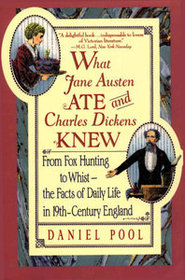Shirin S. (ShirinS) reviewed What Jane Austen Ate and Charles Dickens Knew: From Fox Hunting to Whist-The Facts of Daily Life In Nineteenth-Century England on + 92 more book reviews
Helpful Score: 2
A fascinating book to keep by the bed for a quick dip into research. (I've heard it said that not every detail in this book is actually accurate, although I don't have enough knowledge of the Regency/Georgian/Victorian period to know for sure. Just a caveat in case you base all your research for your next blockbuster ROmance on this book alone.)
Only read parts as reference for a term paper - but the parts were good!
Megan G. (mercurygray) reviewed What Jane Austen Ate and Charles Dickens Knew: From Fox Hunting to Whist-The Facts of Daily Life In Nineteenth-Century England on + 4 more book reviews
I absolutely LOVE this book and wouldn't part with my copy for the world. It is the go-to volume for all things Victorian. Well worth actually buying if you're interested in that period.
David H. reviewed What Jane Austen Ate and Charles Dickens Knew: From Fox Hunting to Whist-The Facts of Daily Life In Nineteenth-Century England on + 3 more book reviews
Frankly I didn't think much of it. I know something about this subject and while I didn't actually find anything inaccurate the information is incomplete, and much of it is presented in a confusing way. An example is the small section on weights and measures. It does a decent job of describing what pecks and bushels etc are, but when explaining distance it says that the mile consists of 5,280 feet and mentions that the furlong (660 feet) comes between the foot and the mile. No mention is made of the yard! A yard is 3 feet of course and a "chain" which was a standard measure for road and railway builders(who used a real chain) was 22 yards and there are 10 chains in a furlong and 8 furlongs in a mile.
Having said that it would be a very useful source of information for any one who is confused about things like Michaelmass and when "the season" was, though if you want complete information this is only a start.
Having said that it would be a very useful source of information for any one who is confused about things like Michaelmass and when "the season" was, though if you want complete information this is only a start.
Patty R. reviewed What Jane Austen Ate and Charles Dickens Knew: From Fox Hunting to Whist-The Facts of Daily Life In Nineteenth-Century England on + 96 more book reviews
From Library Journal
This guide to daily life in 19th-centuryEngland is a welcome companion for readers of Austin, the Brontes, Dickens, and Trollope. The first section is a collection of engrossing short chapters on various aspects of British life, including clothing, etiquette, marriage, money, occupations, society, and transportation. For example, customs now lost but very much practiced at the time were primogeniture, which ensured that the great family houses would not be split up, and the avoidance of eating cheese by the middle class, who considered it a food for the poor. The second part of the book is a glossary of commonly used words or phrases that may be unfamiliar to the modern reader; for instance, tar was a colloquial name for a sailor. Although there are many books on the social history of 19th-century Britain (including several companions to Victorian fiction), this volume is useful because of its concise chapters and lengthy glossary. Recommended for general literature collections.
- Caroline Mitchell, Washington, D.C.
This guide to daily life in 19th-centuryEngland is a welcome companion for readers of Austin, the Brontes, Dickens, and Trollope. The first section is a collection of engrossing short chapters on various aspects of British life, including clothing, etiquette, marriage, money, occupations, society, and transportation. For example, customs now lost but very much practiced at the time were primogeniture, which ensured that the great family houses would not be split up, and the avoidance of eating cheese by the middle class, who considered it a food for the poor. The second part of the book is a glossary of commonly used words or phrases that may be unfamiliar to the modern reader; for instance, tar was a colloquial name for a sailor. Although there are many books on the social history of 19th-century Britain (including several companions to Victorian fiction), this volume is useful because of its concise chapters and lengthy glossary. Recommended for general literature collections.
- Caroline Mitchell, Washington, D.C.
Darragh C. reviewed What Jane Austen Ate and Charles Dickens Knew: From Fox Hunting to Whist-The Facts of Daily Life In Nineteenth-Century England on + 16 more book reviews
interesting for time period information




